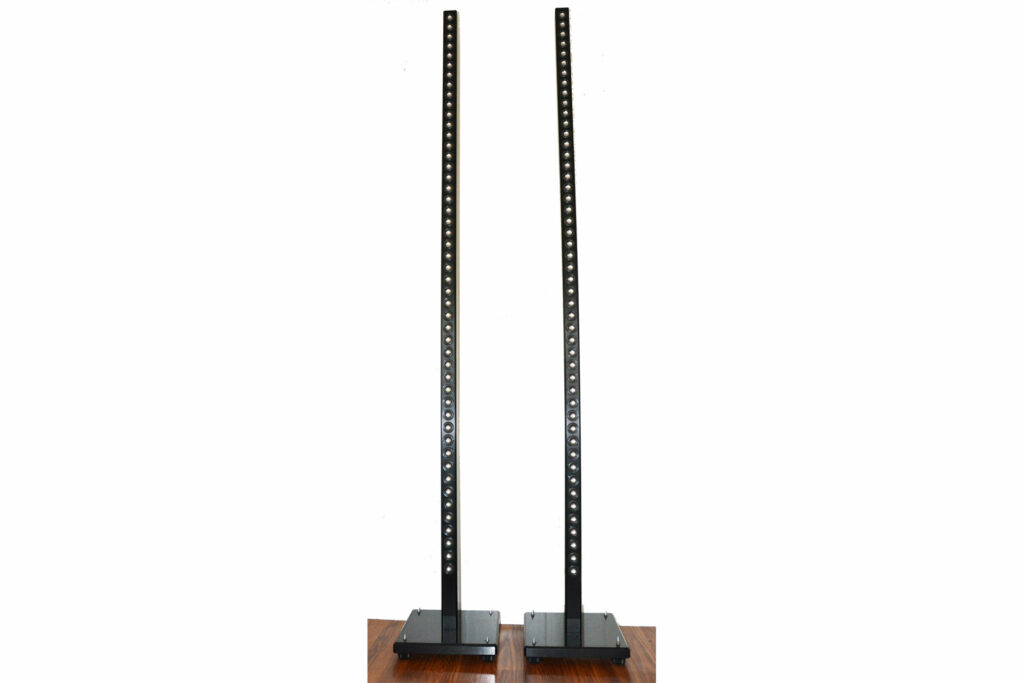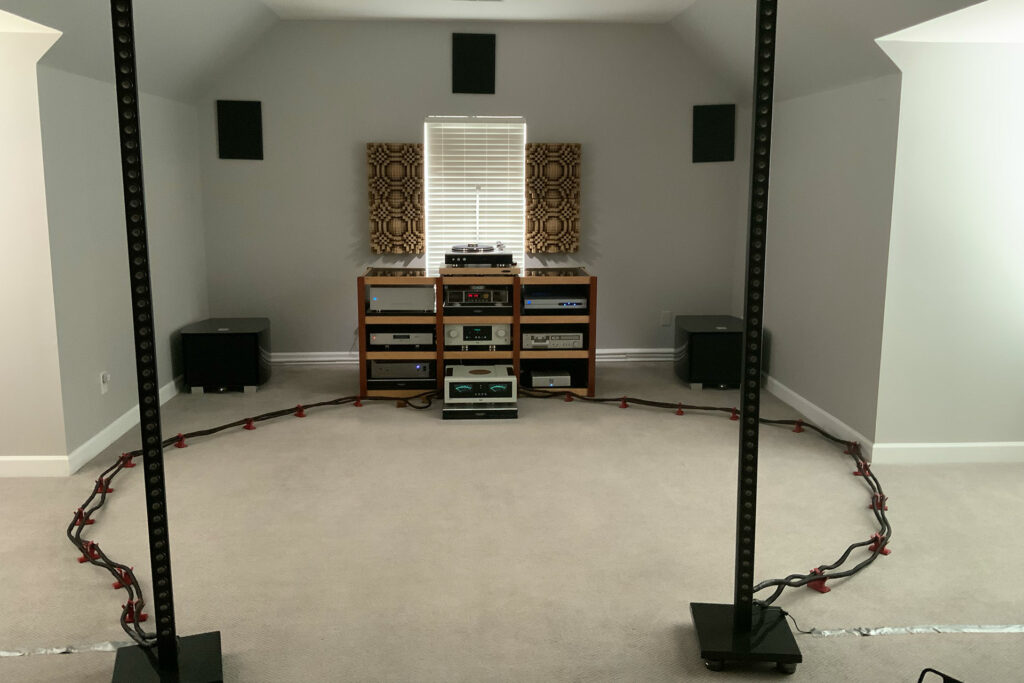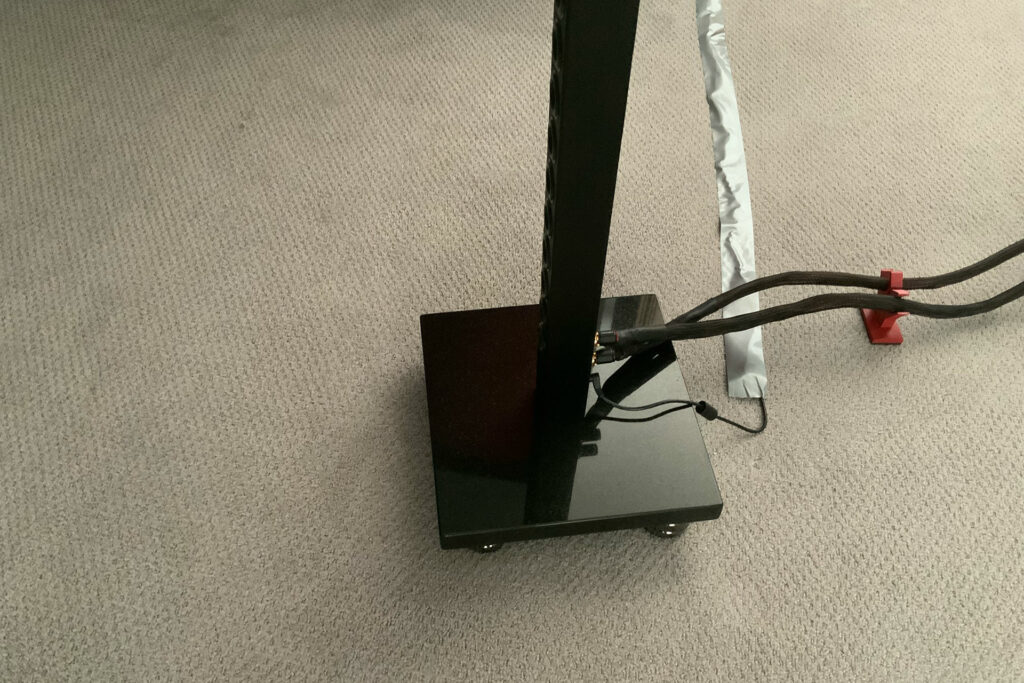Quantum physicist and well-known audio engineer Mark Porzilli, someone who has been designing award-winning audio products for decades, has, since 2019, been updating and perfecting his third and latest line array loudspeaker system: The Note. Manufactured by Laufer Teknik, The Note exemplifies what a well-designed, high-end, line array loudspeaker can achieve. This is a floorstanding speaker system that defies many of the preconceived notions on how dynamic speakers should operate and sound. In fact, The Note delivers the open sound in the mids and highs audiophiles seek from electrostatic speakers with the bass they love from dynamic designs. How do these speakers compete in today’s uber-competitive audiophile landscape? Let’s dig into that.

What Makes the Laufer Teknik The Note Loudspeakers Special?
- The Note is a very thin, very tall loudspeaker consisting of a line of full-range (above the low bass), one-inch drivers in a vertical column. Two versions are available: one with a teardrop shape ($32,500) to facilitate sound dispersion; and the standard two-inch square column ($29,950). Both versions have 48 drivers per tower, or 96 total one-inch drivers. Both versions stand 87 inches tall.
- There is a heating element inside the tower designed to fool the cabinet into thinking it is actually larger than it is. This enables the speaker to play down to the listed 85 Hz, which is sort of amazing considering this part of the speaker is so narrow.
- There is no crossover within the stated frequency range of 85 Hz to 27 kHz. Having no crossover eliminates phase and timing errors always present when audio frequencies are divided into bass, midrange, and treble. Also, with no crossover, there is a purity, especially in vocals, very often lacking in some speakers. I found female vocalists sounded amazingly lifelike and almost like they were in the room with me.
- An equalization network is included to largely keep any frequencies below 85 Hz from reaching the drivers. It is not required, however, meaning the speakers may be directly connected to an amp without the EQ network.
- The Note moves significant volumes of air. It might not look the part, but it is claimed these two thin towers move as much air as two 18-inch woofers. In fact, dynamics are sometimes startling, especially in the upper frequencies, where a cymbal crash or alto horn simply explodes.
- Dynamic compression is virtually eliminated. Most conventional dynamic speakers use a single one-inch tweeter, one or two midrange drivers, and one to four large woofers. A single one-inch tweeter cannot ever hope to move as much air as two, three, or more woofers. It is physically impossible. As the amplitude is increased, the tweeter begins to suffer dynamic compression and cannot produce the requisite decibel output. The Note virtually eliminates compression yielding amazing upper-end frequencies. I have seldom ever heard the upper end of the audio spectrum sound so loud and forceful and equal to the much more dynamic lower frequencies. This is an actual condition called dynamic linearity, where the dynamics are equal from the lowest to highest frequencies.
- These speakers are amazing in their ability to sonically disappear into the room. My listening chair is just over seven feet from each speaker and I never heard one single sound from the speaker itself. All imaging occurs well behind and beyond the cabinets themselves.
- The Note enjoys wide dispersion and is effectively omnidirectional up to about 9,000 Hz and 180 degrees from there to the rated 27 kHz. This wide dispersion makes for an amazing main listening position but also makes off-axis imaging simply stunning. I can move from the far right to the far left of my audio room and the center image never moves. Because of their height, imaging also occurs from just above floor level to six feet high or more.
- Let me be very direct: The Note image unlike any speaker system I have ever heard over many decades of listening to top audiophile loudspeakers. When properly positioned in an appropriately sized room, all imaging occurs well behind the speakers and easily as wide as the room itself. Instruments occur in their own space and enjoy such placement precision, often down to mere inches from as much as 25 feet away, that it gives the feeling one can walk up and shake hands with the musicians. In my audio room, image presentation is anywhere from 16 to 24 feet (front to back) from the listening chair and depending on the recording, as much as 22 feet across. This allows the listener to hear a veritable wall of sound with multiple levels of layering of instruments all across the sound field. When playing a recording of two singers, such as in a Broadway recording, multiple center images are very often heard. This represents two singers standing beside each other onstage.
- Because there are so many drivers, the amount of excursion, or the forward and backward movement of the cone, is negligible. Called overhang, or the resistance of a driver to immediately start and stop, a speaker in a large cabinet with only a few drivers may potentially be slow, have poor dispersion patterns and, because of the amount of excursion of the drivers, create increased distortion. The Note, with each individual driver operating at a negligible fraction of its total capability, all but completely eliminates compression. It also has much lower distortion specs than a conventional dynamic driver speaker system. In fact, when driven with 100 watts of power, it is claimed the total harmonic distortion at 2 kHz is only 0.1 percent and 1 percent at 20 kHz. These are vanishingly small distortion values, especially for a speaker, and one explanation why The Note has such a clean and clear presentation. It actually sounds like music – which seems obvious but is not always the case with conventional speakers.
- The Note loudspeakers can play very loudly when needed. In fact, they are conservatively rated to handle up to 2,000 watts per channel (WPC). They don’t need anywhere near that much power, however, to create any desired amplitude.
Why Should You Care About the Laufer Teknik The Note Loudspeaker?
This is a speaker system that’s all about defying norms. Not only is it not representative of the average “me too” dynamic speaker, this is a transducer whose principal objective is to get closer to the music. And yes, I realize this is an obvious statement and the mission of seemingly all audiophile speaker systems. The Laufer Teknik The Note actually does a remarkable job of creating a natural, almost lifelike presentation, though. I liken the difference to listening to music as opposed to listening to a recording.

Some Things You Might Not Like About the Laufer Teknik The Note Loudspeaker
- A subwoofer is needed for all frequencies of 85 Hz and below. A subwoofer system reaching up to a minimum of 180 Hz is suggested. Laufer Teknik includes an SVS SB-3000 with the sale of each speaker system. If the user already has a subwoofer or would like to choose one on their own, a discount on the retail cost will be applied.
- This is a loudspeaker system that prefers and sounds best when installed in a large listening room. Given enough amplifier power, The Note could easily fill a 50 foot long by 25 foot wide (or larger) listening room with sound. The only restriction on soundstage and image size is the room itself. As such, the larger the room, the better. This might not fit very well with modern households where audio room size is an issue. In my listening room, they are positioned 16 feet from the front wall and 8 feet from each side wall. This makes the soundstage and image presentation fill almost half of my room. The downside is that a large room is required to create such a presentation.
- The Note loudspeakers like a lot of power even if they don’t need it, per se. As previously mentioned, too much power is not the problem here. Laufer Teknik recommends a minimum of 100 WPC and to experience the substantial, sometimes shocking dynamics of which these speakers are capable, a minimum of 200 WPC is even better, as proven in my system. A little more headroom is always a good thing.
- The heating elements, while converted to low voltage, must be plugged into a standard wall outlet. The element heats the internal cabinet volume to about 100 degrees, which is barely noticeable to the touch.
- While excellent recordings will sound remarkable on The Note, poor recordings from a very resolving system can sound positively terrible. These speakers suffer no fools and give exactly what they get. This is a trait I actually prefer as I do not want the system creating something false or inconsistent to the recording.
Listening to the Laufer Teknik The Note Loudspeaker…
On a remake of the 1959 DECCA recording of Puccini’s masterpiece, La Boheme Pavarotti was, as usual, in rare form. I noticed the principal vocalists image presentation seemed to be moving around my audio room. I also noticed the vocals sounded as if they were higher in the room than the music. I realized this was a live recording and I was hearing the singers moving on the stage. The music was presented lower than the vocals because in the live stage production, the orchestra is in the pit and the performers are above on the stage. This level of imaging was completely surprising and something I have never before experienced.
When I first heard the title track “Firecracker” from the Lisa Loeb Firecracker CD, it took me no time at all to pay serious attention to the sonics. What I came to realize was this track was one of the most complex and highly detailed recordings in my music library. There are transients that appear and in an instant are gone. There is all manner of percussion with pops and clicks and making various sounds occurring in multiple points in space all across the area of image development. Some instruments start in the upper left corner of the soundstage and move across the room to the back right corner. All the while, Loeb’s voice is squarely fixed in the center image. Clarity is exceptional, and the capacity of The Note to portray an unbelievable image presentation makes this song all the more dramatic.
Does the Laufer Teknik The Note Have Any Resale Value?
This is somewhat of a tough question to answer. Look in any of the popular used audio gear sites and I seriously doubt you will find very many (if any) used Note speakers for sale. It is important to remember these speakers are very distinctive and are not produced in significant volume. The rarity of the speaker paired with their high level of performance is a good omen, but there just isn’t much empirical data on how they fare on the resale market. My guess is if you were ever to sell a pair of The Notes, you will recoup a sizable portion of your investment.
Who is the Competition for the Laufer Teknik The Note Loudspeaker?
Because of the distinctiveness of this speaker, finding a directly equivalent design is difficult. However, there are several line-array offerings and even omnidirectional designs by several manufacturers.
McIntosh has two line array systems: the XRT1.1K at a retail cost of $60,000 and the XRT2.1K at a cost of $130,000. While classified as line array speakers, both have woofers, midranges, tweeters, and crossover networks. This is a common trait among all dynamic speakers. Still, McIntosh classifies them as a line array. Regardless, because these speakers are three-way, and technically a line array design, they are not directly equivalent to the Laufer Teknik The Note.
MBL has its Radialstrahler line of speakers, all of which offer an omnidirectional presentation. In the floorstanding models, the 116F at $20,000 is the entry level with a few other models up to the world-class, cost-no-object 101 X-treme MKII at $325,000. These speakers are truly one-of-a-kind and do offer omnidirectionality. How much of a direct competitor to the Laufer Teknik The Note they are is debatable.
One speaker with which I have first-hand knowledge is the KEF Blade. I was using a set of the Blades when I replaced them with The Note. Blade is a highly lauded speaker and does, in fact, deliver excellent sonics. I found the highs on my KEF Blades to sound a bit compressed to my ears as compared to The Notes. With that said, there are published measurements on the KEF Blades that they are rock solid in terms of high frequency performance so let’s mark this detail up to personal preference. The Blade projects a 360-degree dispersion pattern but falls to about 180 degrees just slightly above the low bass. The Note delivers 360-degree dispersion up to about 9,000 Hz, so imaging is vastly superior. The lack of overall compression in The Note delivers a cleaner, clearer, and more natural sound as compared to the Blade. The KEF Blade retails for about $34,000, depending on the version.
Basically, all dynamic speakers are similar in design and therefore different in operation than the Laufer Teknik The Note. With The Note lacking significant dynamic compression, and delivering a 360-degree radiation pattern through so much of the frequency spectrum, most dynamic speakers have certain failings their design simply finds quite difficult to overcome – at least affordably. All speakers, including The Note, must make compromises. It’s up to the listener to decide which speaker system, and their associated design, is the most pleasing and therefore most desirable.

Final Thoughts on the Laufer Teknik The Note Loudspeaker System
It would be very easy to consider this speaker system little more than a bunch of cheap, off the shelf, one-inch tweeters stuck in a tall, thin, column. But nothing could be further from the truth. Through the complex physics of making multiple drivers combine, given all image development occurring so far behind the towers, given their ability to completely and absolutely disappear into the room, given the incredible dynamics from the upper bass up to the ultrasonics, given the incredible clarity and accuracy, the Laufer Teknik The Note is an amazing achievement. While not a speaker system for the masses, when correctly positioned in a large enough room and given adequate power, The Note will be a speaker system that will truly amaze.
Perhaps the most difficult decision regarding The Note Loudspeaker System is the willingness to deviate from the norm and venture into a somewhat unknown territory. This is a speaker quite unlike conventional dynamic speakers. Yet their attributes simply cannot be ignored once heard. These speakers will reinvent the art and practice of a high-performance transducer and give the listener exactly what they want – a supremely enjoyable and unbelievable listening session. Only thing required is the willingness to consider something radically different.



